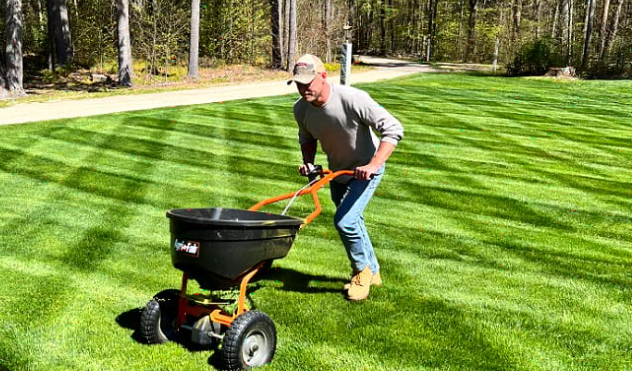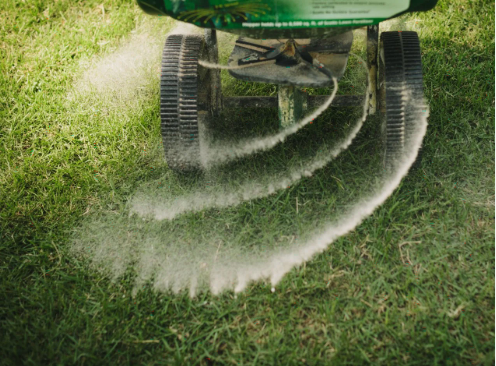
A lush, green lawn doesn’t just appear overnight. It requires thoughtful care, including a well-planned fertilization routine. Whether you’re a seasoned gardener or a homeowner looking to boost your lawn’s health, understanding the essentials of lawn fertilization is crucial. This guide will walk you through proven fertilization techniques, helping you know when to fertilize the lawn, what type of fertilizer to use, and how to apply it effectively.
Why Fertilizing Your Lawn Matters
Fertilizer is to grass what vitamins are to humans. Lawns need essential nutrients to grow strong, resist weeds, and develop a rich green color. Without proper fertilization, grass can become patchy, susceptible to disease, and lose its lush look. Fertilization ensures your lawn gets the nutrients it needs to thrive, particularly the “big three” — nitrogen (N), phosphorus (P), and potassium (K). Nitrogen promotes vibrant green growth, phosphorus strengthens roots, and potassium boosts the lawn’s overall health and resilience.
However, timing and technique are everything. By understanding how and when to fertilize the lawn, you can give it the best chance to flourish.
Types of Lawn Fertilizers
Not all fertilizers are created equally, and choosing the right one for your lawn’s needs will set you on the path to success.
Synthetic Fertilizers
Synthetic fertilizers offer quick results. These fast-acting formulas deliver a concentrated dose of nutrients to your grass, making them an ideal choice if you’re looking to see an immediate improvement in your lawn’s appearance. However, they can sometimes cause “fertilizer burn” if not used properly, so it’s essential to follow package instructions closely.Organic Fertilizers Organic fertilizers, derived from natural materials like compost, bone meal, and manure, work more slowly but are gentle on the grass and improve soil structure over time. By adding organic matter to the soil, they support beneficial microbes and build long-term soil health. Organic fertilizers are an excellent choice for those looking for sustainable lawn care.
Liquid Fertilizers
Liquid fertilizers are fast and easy to apply, as they are usually applied using a hose-end sprayer. They are rapidly absorbed and give a quick boost to grass. However, because they release nutrients quickly, they may need to be applied more frequently.Granular Fertilizers
Granular fertilizers, available in slow-release and quick-release formulas, offer more control over nutrient release. Slow-release versions provide a steady nutrient supply over time, meaning fewer applications are needed. They are ideal for homeowners who prefer a low-maintenance approach.
When to Fertilize the Lawn: Timing is Everything
One of the most common questions about lawn fertilization is knowing when to fertilize the lawn. Timing depends on the type of grass you have and the region’s growing season, but here’s a general breakdown that works for most lawns:
Early Spring: Once your lawn begins to show signs of green after winter dormancy, it’s time for the first application. This is typically when the soil temperature reaches around 55°F (13°C). Fertilizing early jumpstarts growth and provides essential nutrients as the grass begins its active growth phase.
Late Spring: Around May, your lawn can benefit from a second application. This time, avoid high-nitrogen fertilizers, as they can encourage excessive growth that may weaken the grass during the summer heat.
Summer (if needed): If you have warm-season grasses, such as Bermuda or Zoysia, they’ll appreciate a dose of fertilizer during the summer as they reach their peak growth. However, for cool-season grasses, it’s best to skip fertilizing during hot summer months to avoid stressing the grass.
Early Fall: For all grass types, early fall is one of the most critical times to fertilize. The cooler temperatures make it easier for the grass to absorb nutrients and store energy for winter. Fertilizing now helps your lawn recover from summer stresses and prepares it for winter dormancy.
Late Fall: A final application before winter can help strengthen roots and prepare the grass for spring growth. Often called a “winterizing” fertilizer, it’s typically a blend that emphasizes potassium for root health over nitrogen.
Best Practices for Fertilizer Application
Using proper techniques when applying fertilizer can make a significant difference in its effectiveness. Here are some tried-and-true methods:
Using a Spreader
A spreader ensures even coverage across your lawn for granular fertilizers. Depending on the size of your lawn, a broadcast or drop spreader works well. Set the spreader to the appropriate setting and walk at a steady pace, slightly overlapping rows to avoid gaps.Watering After Application
Watering after fertilizing is crucial for helping nutrients penetrate the soil. This practice prevents fertilizer burn, particularly with synthetic products. Watering lightly will be enough to dissolve the granules, allowing the nutrients to move into the soil.Avoid Fertilizing Wet Grass
Fertilizing wet grass can cause granules to stick to the blades, leading to uneven distribution. For the best results, apply fertilizer when the grass is dry.Liquid Fertilizer Application
If you’re using liquid fertilizers, consider a hose-end sprayer to distribute it evenly across your lawn. Liquid fertilizers need careful application to avoid over-application, as they can be potent.
Customizing Fertilization for Different Grass Types
Different types of grass have different needs, and tailoring your fertilization strategy based on the type of grass will enhance results.
Cool-Season Grasses
Cool-season grasses like fescue, ryegrass, and Kentucky bluegrass benefit most from fertilization in early spring and fall. These grasses typically go semi-dormant in summer, so it’s wise to avoid heavy fertilization during this period.Warm-Season Grasses
Bermuda, St. Augustine, and Zoysia thrive best with fertilization in late spring and summer, coinciding with their peak growth period. A balanced fall application also helps these grasses prepare for winter.
Common Fertilization Mistakes to Avoid
Over-fertilizing is a mistake many make, thinking it will lead to a greener lawn faster. However, too much fertilizer can burn your grass and disrupt the soil’s nutrient balance. Here are some other common mistakes to watch for:
Skipping Soil Testing
A soil test provides valuable information on nutrient levels so you know precisely what your lawn needs. Testing your soil every few years helps you choose the right fertilizer and avoid over-fertilizing.Applying Fertilizer Just Before Heavy Rain
Fertilizing right before a rainstorm can lead to runoff, wasting nutrients, and potentially contaminating nearby water sources. Plan applications when light rain or watering can activate the fertilizer without washing it away.Ignoring Soil pH
Fertilizers are most effective when soil pH levels range between 6.0 and 7.0. If your soil pH is too low or too high, your grass may not absorb nutrients as efficiently. Regular pH testing can ensure your lawn remains in optimal condition.
Signs Your Lawn Needs Fertilization
Some visible signs indicate your lawn may be overdue for fertilization:
Yellow or Pale Green Color
Grass that appears yellow or pale green often lacks nitrogen, a key nutrient for healthy growth.Thinning Grass
If your lawn looks sparse or patchy, it may need more phosphorus or potassium to encourage root and shoot development.Weak Recovery from Traffic
Grass that doesn’t bounce back from foot traffic is often nutrient-deficient. A robust fertilization program strengthens grass blades, allowing them to recover faster.
Environmental Considerations
Responsible fertilization is essential to prevent harm to the environment:

Avoid Runoff
Apply fertilizer carefully to prevent it from spilling onto sidewalks, driveways, or streets, where it could wash into storm drains and waterways. Use borders to keep fertilizer within the lawn.Organic Alternatives
Organic fertilizers are slower but offer sustainable benefits to soil health. Consider organic options to enhance your lawn and protect the ecosystem.
Lawn fertilization is an art and a science. Knowing when to fertilize the lawn, choosing the right product, and following proper application techniques will help you maintain a healthy, green lawn year-round. A consistent fertilization routine tailored to your grass type and region’s climate can transform your yard, making it the envy of the neighborhood.
By using these lawn fertilization techniques, you’ll create a landscape that looks beautiful, supports the environment, and provides a green oasis right outside your door.



(0) comments
We welcome your comments
Log In
Post a comment as Guest
Keep it Clean. Please avoid obscene, vulgar, lewd, racist or sexually-oriented language.
PLEASE TURN OFF YOUR CAPS LOCK.
Don't Threaten. Threats of harming another person will not be tolerated.
Be Truthful. Don't knowingly lie about anyone or anything.
Be Nice. No racism, sexism or any sort of -ism that is degrading to another person.
Be Proactive. Use the 'Report' link on each comment to let us know of abusive posts.
Share with Us. We'd love to hear eyewitness accounts, the history behind an article.